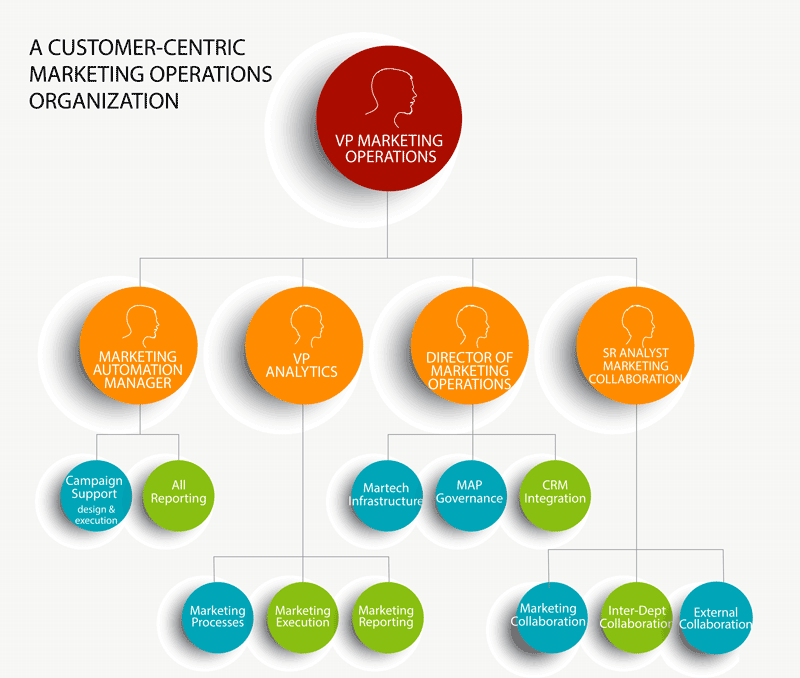Becoming customer-centric: A tale of a changing MO organization
Contributor Debbie Qaqish describes the structure of a marketing operations group that's increasing in sophistication.
The martech world is changing so quickly that we often overlook one of the key tenets of effective management: aligning organizational structure to strategy.
I have been fascinated with the various organizational charts for the marketing ops (MO) function and have written a few articles on the topic.
In this article, I’d like to highlight how one particular MO org structure changed over time in response to market and company demands. In future articles, I will highlight different types of MO organizations.
A simple marketing operations maturity model
To effectively review and assess an org structure of an MO function, we should start by defining a simple maturity benchmark.
- Stage 1 is when marketing is unaware of the need for a dedicated MO organization. Clearly, we are moving past this!
- Stage 2 is Efficiency, in which the MO team focuses on doing things well. Examples include optimizing the use of the marketing automation system and ensuring systems are implemented and integrated correctly. This is largely a reactive organization taking assignments as they occur.
- Stage 3 represents the Effective MO organization and is characterized by doing the right things. This MO group is more proactive and is often found to be responsible for re-engineering core processes such as lead management and for bringing forward new ideas and innovations to better meet goals.
- Stage 4 is the Customer-centric MO organization, the key to helping the company pivot from a product-centric to a customer-centric organization. Team members work as collaborators across functions to ensure the exchange of customer data aids the customer journey across all touch points.
- Stage 5 is what I call Next Generation and is characterized by a radical new organizational structure in which all customer-oriented operations functions report into one organization. This group becomes the “owner” of the all the threads that create an optimal customer experience.
Case study: Technology company moving from Efficient to Customer-centric
The MO group in this billion-dollar company is part of an 80-person global marketing team and has been in existence for eight years. The same VP of Marketing Ops has led and built this team from day one. This VP is responsible for developing and orchestrating the processes and systems required to enable efficient and effective marketing.
More specifically, MO staff members are responsible for developing and managing the processes to ensure smooth operations of strategic planning, lead management, marketing performance management, marketing infrastructure and overall marketing excellence.
It is their focus on process (including lead management) and their proactive leadership role in marketing that places this company in the Effective stage of MO maturity. Recently, however, the company pivoted from a product-centric to a customer-centric strategy, which moves this MO group into the Customer-centric level of maturity.
Over the last year, the MO function has played an instrumental role in developing and executing the customer-focus market strategy, and as a result, the senior management team now has a more strategic set of expectations for this function.
The biggest changes in this MO organization over the last year have occurred in two areas. First, this team has been an integral part of the pivot to customer focus as described above. The MO team’s technical knowledge, project management skills and ability to coordinate and communicate up and down the company helped ensure success for the pivot.
The second change is the ongoing maturity of the team. This team has been together for quite a while, and they continue to enhance their skill set and value to the firm as the firm asks them to step up in key areas.
Other key and unique responsibilities for the VP of Marketing Operations in this company include establishing and managing the budget, as well as integrating the frequent company acquisitions and managing the partner program. This is a busy team.
Reporting to the VP of MO are key functions led by a Director of MO, a Marketing Automation Manager, a VP of Analytics and a Senior Analyst Marketing Collaboration.
The Director Marketing Operations manages a team responsible for the marketing technology infrastructure, MAP governance, CRM integration, oversight on the global lead management process, enabling customer segment marketing, generating and analyzing performance metrics and reports and maintaining budget management tools.
The Marketing Automation Manager is responsible for all marketing automation systems and processes as supporting regional teams for campaigns, including direct support of campaign design and execution. This team is also responsible for all reporting and analytics related to marketing automation.
The VP of Analytics is a senior role responsible for overall marketing reporting and analytics processes and execution. The VP develops a vision for reporting improvements that match marketing strategies and intelligence requirements. For strategic reporting on leads, pipeline, product performance, marketing ROI and special initiatives, the VP develops reports and publishes key data. The VP leverages BI and visualization tools to create executive summaries and dashboards to help with effective critical intelligence visibility. The VP looks for innovative ways to leverage intelligence to drive better performance and better outcomes as he works with marketing, sales and the executive team.
The Senior Analyst Marketing Collaboration is a unique position that I have not seen in other organizations. This person is responsible for defining the vision, strategies and objectives for marketing collaboration within the marketing function, between marketing and other internal functions and between marketing and entities outside the company. This person defines requirements for ideal collaboration related to all facets of marketing and defines a roadmap and a set of technologies to move toward the ideal state.
In my next article, I will highlight a very different MO organization. All MO groups are a function of the unique needs of their company. We see many configurations, and there is no right or wrong. What is important is to be intentional in the structure and to ensure the structure meets marketing’s strategic demands to achieve the company’s measurable growth objectives.
Opinions expressed in this article are those of the guest author and not necessarily MarTech. Staff authors are listed here.
Related stories

